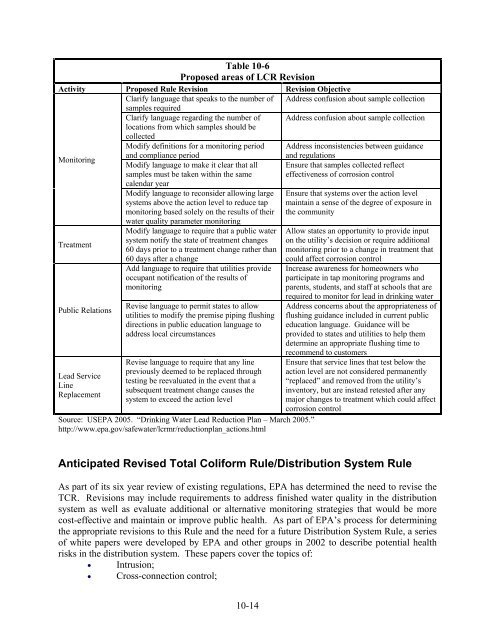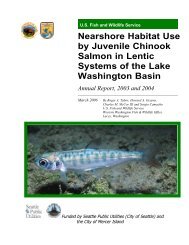2006 Water Comprehensive Plan - City of Bellevue
2006 Water Comprehensive Plan - City of Bellevue
2006 Water Comprehensive Plan - City of Bellevue
- No tags were found...
You also want an ePaper? Increase the reach of your titles
YUMPU automatically turns print PDFs into web optimized ePapers that Google loves.
Table 10-6Proposed areas <strong>of</strong> LCR RevisionActivity Proposed Rule Revision Revision ObjectiveClarify language that speaks to the number <strong>of</strong> Address confusion about sample collectionsamples requiredClarify language regarding the number <strong>of</strong> Address confusion about sample collectionlocations from which samples should becollectedModify definitions for a monitoring period Address inconsistencies between guidanceMonitoringTreatmentPublic RelationsLead ServiceLineReplacementand compliance periodModify language to make it clear that allsamples must be taken within the samecalendar yearModify language to reconsider allowing largesystems above the action level to reduce tapmonitoring based solely on the results <strong>of</strong> theirwater quality parameter monitoringModify language to require that a public watersystem notify the state <strong>of</strong> treatment changes60 days prior to a treatment change rather than60 days after a changeAdd language to require that utilities provideoccupant notification <strong>of</strong> the results <strong>of</strong>monitoringRevise language to permit states to allowutilities to modify the premise piping flushingdirections in public education language toaddress local circumstancesRevise language to require that any linepreviously deemed to be replaced throughtesting be reevaluated in the event that asubsequent treatment change causes thesystem to exceed the action levelSource: USEPA 2005. “Drinking <strong>Water</strong> Lead Reduction <strong>Plan</strong> – March 2005.”http://www.epa.gov/safewater/lcrmr/reductionplan_actions.htmland regulationsEnsure that samples collected reflecteffectiveness <strong>of</strong> corrosion controlEnsure that systems over the action levelmaintain a sense <strong>of</strong> the degree <strong>of</strong> exposure inthe communityAllow states an opportunity to provide inputon the utility’s decision or require additionalmonitoring prior to a change in treatment thatcould affect corrosion controlIncrease awareness for homeowners whoparticipate in tap monitoring programs andparents, students, and staff at schools that arerequired to monitor for lead in drinking waterAddress concerns about the appropriateness <strong>of</strong>flushing guidance included in current publiceducation language. Guidance will beprovided to states and utilities to help themdetermine an appropriate flushing time torecommend to customersEnsure that service lines that test below theaction level are not considered permanently“replaced” and removed from the utility’sinventory, but are instead retested after anymajor changes to treatment which could affectcorrosion controlAnticipated Revised Total Coliform Rule/Distribution System RuleAs part <strong>of</strong> its six year review <strong>of</strong> existing regulations, EPA has determined the need to revise theTCR. Revisions may include requirements to address finished water quality in the distributionsystem as well as evaluate additional or alternative monitoring strategies that would be morecost-effective and maintain or improve public health. As part <strong>of</strong> EPA’s process for determiningthe appropriate revisions to this Rule and the need for a future Distribution System Rule, a series<strong>of</strong> white papers were developed by EPA and other groups in 2002 to describe potential healthrisks in the distribution system. These papers cover the topics <strong>of</strong>:• Intrusion;• Cross-connection control;10-14
















